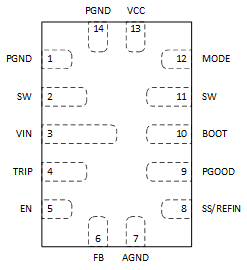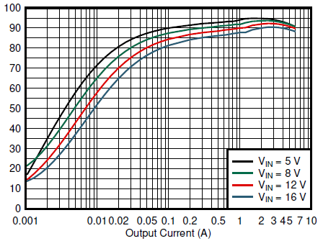SLVAFV6 September 2024 TPS544C26 , TPS548A28 , TPS548B23 , TPS548B28 , TPS548C26 , TPS548D26 , TPS54J060 , TPS54J061 , TPS54KB20 , TPS54KC23 , TPS566231 , TPS568231 , TPS56C231 , TPS62903 , TPS82130
Enterprise solid state drives (eSSD) are widely used in data center applications all over the world. eSSDs offer faster speeds and smaller sizes then the standard hard disk drives (HDD). Data centers involve millions of bytes of data being processed constantly around the clock for this, the eSSD must provide low-latency and must be accessible to a large number of users that need access to the data stored. Because of this the system power designs must be able to be optimized for performance and efficiency and be compact due to size constraints. This article discusses eSSD design challenges and how point of load buck regulators addresses them.
Table 1 lists devices that are highlighted for eSSD power management. Included are both digital and analog designs in discrete form factors. Digital designs include PMBus for voltage scaling and telemetry.
| GPN | Vin | Iout | Package |
|---|---|---|---|
| TPS544C26 | 4V to 16V | 35A | 5x6 QFN HR |
| TPS568231 | 3.8V to 17V | 8A | 3.5x3.5 QFN HR |
| TPS56C231 | 3.8V to 17V | 12A | 3.5x3.5 QFN HR |
| TPS54J060 | 2.7V to 16V | 6A | 2x3 QFN HR |
| TPS54J061 | 2.7V to 16V | 6A | 2x3 QFN HR |
| TPS548A28 | 2.7V to 16V | 15A | 3x4 QFN HR |
| TPS548B28 | 2.7V to 16V | 20A | 3x4 QFN HR |
| TPS548C26 | 4V to 16V | 35A | 5x6 QFN RLF |
| TPS548D26 | 4V to 16V | 40A | 5x6 QFN RLF |
| TPS54KB20 | 4V to 16V | 25A | 3x3.5 QFN HR |
| TPS54KC23 | 4V to 16V | 30A | 3x3.5 QFN HR |
| TPS566231 | 3V to 17V | 6A | 2x1.5 QFN HR |
| TPS62903 | 3V to 17V | 3A | 2x1.5 QFN HR |
| TPS548B23 | 4V to 16V | 20A | 3x3 QFN |
| TPS548A23 | 4V to 16V | 12A | 3x3 QFN |
| TPS82130 | 3V to 17V | 3A | 3x2.8 MicroSiP |
High-Efficiency in a Compact Form Factor Design
High-efficiency, power-dense designs benefit all kinds of SSD devices. When making Enterprise SSDs smaller, the challenge of creating high-efficiency compact designs becomes relevant. The limited board space in some equipment requires a greater emphasis on a small footprint power design. A key device family for this challenge can be the TPS54J060 and TPS54J061 family of converters. This family of devices come in a 2x3mm QFN 14-pin package that is easy to use with minimal external components. The key feature for these devices is the ability to provide high-efficiency while running FCCM or ECO MODE which also provides high light load efficiency. Another device to consider is TPS548B23 and TPS548A23 family. This family comes in 12A and 20A and offers high-efficiency even at heavy loads. TPS548B23 comes in a 3x3mm QFN package which also allows for additional airflow allowing the best thermal performance. Figure 1 is an efficiency graph. Figure 2 is an image of the packages for the devices discussed.
 Figure 1 TPS548B23 Efficiency at VIN =
12V, external VCC = 3.3V, FCCM, Fsw = 800kHz
Figure 1 TPS548B23 Efficiency at VIN =
12V, external VCC = 3.3V, FCCM, Fsw = 800kHz Figure 2 TPS548B23 Package Top
View
Figure 2 TPS548B23 Package Top
View Figure 3 TPS54J060 Package Top
View
Figure 3 TPS54J060 Package Top
View Figure 4 TPS54J060 Efficiency at VIN =
12V, External VCC = 1.8V, FCCM, Fsw = 600kHz
Figure 4 TPS54J060 Efficiency at VIN =
12V, External VCC = 1.8V, FCCM, Fsw = 600kHzOutput Voltage Accuracy
Output voltage accuracy is the ability of a voltage regulator IC to maintain a specific output voltage within a tolerance range while in various operating conditions. The output voltage accuracy of a device is crucial for performance and to maintain that the design receives the correct voltage while also maintaining stability. If the output voltage is inaccurate, the voltage can lead to improper performance as well as damage to the build. If the output voltage is too high the voltage can cause overheating and system failure. On the contrary if the output voltage is too low, the voltage can cause malfunctions as well as unreliability. A device that supports high output voltage accuracy allows for minimal damage or risk of malfunction. Looking at our portfolio there are many devices with high output voltage accuracy since this is a standard feature for most devices. Devices like the TPS54KB20 family offer high output voltage accuracy while also being a high efficiency compact device in 3 x 3.5mm butterfly package. Lower current options are also available with similar features. Devices like TPS82130 also provide high output voltage accuracy at lower current ranges coming in at 3A.
Conclusion
When looking into power management designs for enterprise SSDs, several key requirements involved need to be considered to choose the most optimized device. Power dense buck converters and modules help the equipment as well as optimize your devices. The high-efficiency, small form-factor devices highlighted helps with space constraints and allows for better performance in general. Lastly, having devices with high-output-voltage accuracy allows for better and more stable performance while lowering the risk of damage or malfunction for the device.